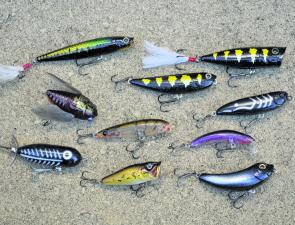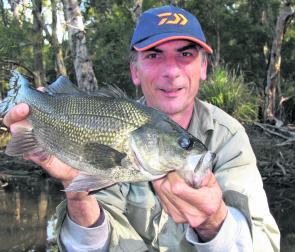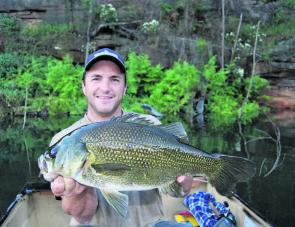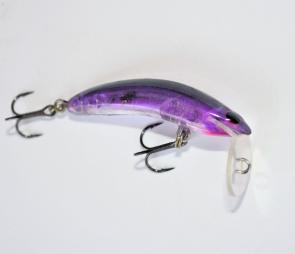Of all the species of fish I’ve chased over the years, I rate bass as one of the easier ones to fool with lures, probably because they eat a diverse range of creatures. Crickets, spiders, moths, prawns, shrimp, worms, herring and small mullet are just a small portion of what bass devour.
At times bass may focus on a particular form of food and that tends to happen when there is an insect hatch or some other sort of extra abundance of one thing or another. When this happens, bass may ignore almost everything we throw at them unless we happen to have a lure or fly that very closely resembles what they’re feeding on.
This can be incredibly frustrating, but it’s all part of the world of bass fishing.
Such phenomena aside, most of the time bass aren’t overly fussy. But it’s always a good idea to use lures that in some way resemble what bass generally eat in a particular waterway.
In some rivers their main diet may be herring, with the occasional side serving of mullet and a sprinkling of cicadas. At another place the local bass may be mainly insect feeders and so will be on the lookout for things falling from above.
Because of this, some lures that work brilliantly on river X or impoundment Y may not work as well as others on river A or impoundment B.
The bass fanatic is normally a bit of a lure collector as well and some of these people haul along a truckload of lures when they go bass fishing. So if an angler is observant, they can select a suitable lure to suit what’s going on around them.
Most of us don’t carry a huge number of lures when we fish and I’m an extreme minimalist, often bringing along only half a dozen lures at the most or double that if I’m doing an overnight trip.
So when cutting back on lures like that it’s obviously beneficial to bring the right ones. How can we be sure of the right lures, then?
By having some really good lures with you, you’re putting yourself in with a reasonable chance. Like a lot of bass anglers, I use a variety of types from soft plastics to spinnerbaits and hardbodies.
Some people strictly use surface lures. I’m definitely not like that because bass won’t always hit surface lures and I reckon catching fish is the main aim, regardless of how much fun it is to see your lure get demolished on the surface.
For those new to bass fishing or who may be looking for some new ideas this season, I’ve prepared a list of 10 topwaters that have served me well over the past few years.
Some have been around for ages, while others are much newer.
I’m certainly not placing any one of these at the top of the list – as each of them has their day – but all have been proven and I can highly recommend them.
Not long before these lures hit our shores, the smaller Jackson T-Pivot had proven itself for bass, bream and a number of other species. The larger B-Pivot makes a lot more sense.
It casts farther, makes more noise on the surface, is a larger target for bass to zoom in on, has larger and stronger hooks which are ideal for big bass and it’s not so likely to be completely engulfed and wedged deep inside the mouth of a fish.
Tiny lures may work but if you use them all the time, you’ll soon encounter the problem of trying to get a lure out that’s stuck down a fish’s throat.
The B-Pivot can be made to walk the dog but with a bit of practice you can get it to dance around a lot without moving forward as much as other lures.
This simply means it stays in the strike zone for longer and so may encourage a bass to hit. With a few sharp jerks on the rod with the tip pointed down, you can also get the B-Pivot to push a bit of water like a popper.
These are quality Japanese lures without a hefty price tag. At 55mm they are a good size for bass and cast like bullets.
While not being an outrageously flash-looking lure, the most important thing is that they work exceptionally well.
On a number of occasions the Maria Pencil has saved my trip while other lures haven’t gained much attention.
Again, it’s not too hard to get them walking across the top and they’re very durable lures that can handle being bounced off the odd log or rock.
The larger Grand Siglett and the smaller Siglett are excellent surface lures, although the most expensive on my list.
I had a great introduction to these lures on an overnight trip a few years ago when my old faithful purple spinnerbaits and other lures could hardly score a bite. One cast with the Grand Siglett had me hooked up and the fish kept coming.
Admittedly this took place amid the deafening roar of cicadas so the Siglett was used in the right place at the right time on focused fish.
Since that day, I’ve enjoyed some great surface sessions with both Siglett sizes and while at first I preferred the model with the furry belly, I now don’t think it makes much difference.
Both versions are quite expensive. Are they worth it? Yes, but shop around for the best prices.
If the points of the double hooks face upwards it means that the Siglett will pick up less weed or surface scum, but you’ll enjoy a much better hook-up rate if the hook points are facing down. Another tip is to superglue or Araldite the hook eyelet so it doesn’t spin around or even fall out.
Be sure to have the hooks facing the right way before gluing the eyelet, though.
The oldest lure in my list, Heddon Torpedos have caught me many bass over the years and hopefully many to come.
They come in a few different sizes, but the 48mm Tiny Torpedo and 65mm Baby Torpedo are generally the best in most places.
Just be sure that those metal propellers are spinning freely and the hooks are sharp.
This is a completely different type of lure and proudly made in Lithgow NSW by well-known angler and magazine writer Alex Hickson. A keen and knowledgeable freshwater fisho, Alex knows how to make a good lure and the Pop n Crank is basically a modified version of his diving Crank Minnow.
On a slow retrieve with rod tip pointed down, it enticingly wiggles across the surface and a quick jab of the rod can make it pop like a conventional popper.
They’re not widely known and the bib arrangement looks a bit odd, but they work incredibly well on bass and have scored me bites on days when I’ve struggled with other lures.
Big brother of the PX45, this is just a good surface lure to have in the kit at any time. Not being overly big or noisy, the PX55 is inclined to score hits on those days when bass aren’t quite so active.
As is the case with the Jackson T- and B-Pivots, the smaller PX45 also works well on bass but often the fish inhale the little lure and trying to extract it can cause major mouth, throat or gill injuries.
For this reason I always recommend the PX55 over the PX45.
The Sammy has become a very popular topwater lure over the past five years and I’ve met a few people who reckon it’s their favourite lure. I wouldn’t put it at the top, as I wouldn’t put any others right at the top either.
However, I’ve enjoyed most success with the Sammy 65 in places where bass feed a lot on small fish rather than insects. It can be walked in a very subtle way and is also good for when bass are a bit hesitant about hitting a surface lure.
The larger Sammy 85 is another good one, especially where big bass lurk or there’s a chance of a cod.
The Gunfish 75 is a noisier lure than the Sammy and can be made to splash and spit a bit more water.
It’s been a consistent performer for me over the past few years, scoring some good sized bass in rivers and dams. Overall, I’ve enjoyed a bit more success with the Gunfish than the Sammy, but both have places in my bass box.
Another Lucky Craft product, the G-Splash is just a really good largish sort of popper. It’s very well made, fitted with decent hooks and it’s easy to get these lures to splash a lot of water, so they can bring bass up out of deeper water to have a look.
The larger G-Splash 80 is also good in places where bigger bass live but the 65 is more versatile.
Although we’ve got all these weird and wonderful surface lures on the market, I still reckon it’s a good idea to have a few simple 45mm-50mm poppers in the box.
There are plenty worth casting and some reliable names to look for are the River2Sea Bubble Pop, Rebel Pop R and the Lucky Craft Bevy Popper.
These little poppers rarely fail, but if they do then consider some of the other lures mentioned above.
• Next month – how to get the most from your surface lures
Facts
THE REST
Of course, there are plenty of other good surface lures around and some that I know are people’s favourites include the OSP Bent Minnow, Arbogast Jitterbug and Taylor Made Fizzers. Perhaps some of these work better on your local waters than the models in my top 10.
If however, you haven’t tried some of the lures listed here, give them a go; I’m sure you won’t be disappointed.
Remember too that any of these lures won’t catch bass by themselves. Casting accuracy and a bit of thought and effort are every bit as important as the lure dangling from the end of the rod.

Ten topwater lures that the author rates very highly for bass. From left: top row, Lucky Craft Gunfish75, Lucky Craft Sammy 65, Lucky Craft G-Splash 65; middle row Megabass Siglett, Ecogear PX55, Viking Pop ’n’ Crank, Maria Pencil; bottom row Heddon Torpe

This fish smashed a 55mm Maria Pencil slowly walked over the top of a large submerged log.

Tournament angler Wayne Beazley used a simple 50mm popper to good effect at Lake St Clair, snaring a number of good bass after sunset and again very early in the morning.

This impoundment bass smashed a Lucky Craft Sammy near some shaded rocks. The Sammy is a favourite of many anglers but there are a number of great surface lures out there that are just as good. Different lures work better on different days at different lo

The Jackson B-Pivot is one of the author’s favourites and has proven successful on quite a few different waterways.

Poppers are always in with a chance. In this case a Lucky Craft G-Splash 65 did the damage.

While the Lucky Craft Sammy is a very popular bass lure, the author rates the slightly noisier Lucky Craft Gunfish as just as good, if not better.

The Aussie made Viking Pop n Crank may at first seem a bit unconventional but it’s a real winner on bass. It wiggles across the surface and can be made to pop and splutter.




